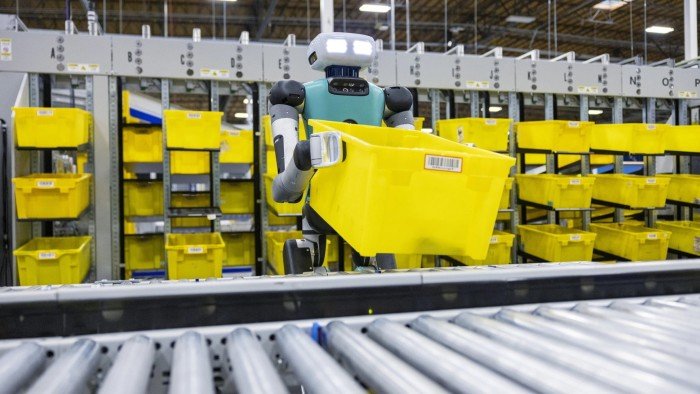Unlock the Editor’s Digest for free
Roula Khalaf, Editor of the FT, selects her favourite stories in this weekly newsletter.
With its clamp-shaped hands and legs that bend backwards, one of the latest humanoid robots tried to move a can from a supermarket shelf into a shopping basket in front of attendees at a Silicon Valley tech conference.
“I missed 🙁,” the machine, made by Agility Robotics, told onlookers via an app before succeeding a second time.
The demonstration highlighted the imperfect but fast advancing state of humanoid robotics.
A host of companies including Agility, Boston Dynamics, Figure and Elon Musk’s Tesla are developing two-legged robots to deploy in industrial settings. Ecommerce giant Amazon and car manufacturers BMW and Mercedes-Benz are already testing them in factories and warehouses.
Melonee Wise, chief product officer at Agility, says the company’s robots can serve as a link between “islands of automation” consisting of more conventional robotics. “Humanoids connect all of these very structured . . . processes that don’t currently have good connectors,” she says.
Analysts at the Bank of America forecast that 1mn humanoid robots will be in operation by 2030, from almost nothing today. The projected boom offers manufacturers and logistics providers an opportunity to automate processes that have previously been out of reach, helping lower production costs and increase efficiency.
Yet these humanlike machines are prompting fiery debates around safety, form and function.
“We will add vision to give robots planning capabilities, the ability to understand speech and will add mobility,” says Sami Atiya, head of robotics at manufacturer ABB. “The question is, at the end, what shape is going to come out. Is it a humanoid? We believe it might be different.”
ABB has developed robotics for several decades, having deployed mechanical arms that have carried out a range of manufacturing tasks from welding through to assembly.
The Swiss industrial group is betting that customers are seeking a less familiar form when they come to deploy more advanced robotics: “I’ve yet to meet a customer who wants a robot on legs,” says Atiya.
ABB’s two-armed Yumi robots are being deployed affixed to a drive unit on wheels, with cameras helping the system navigate.
Ken Goldberg, a robotics professor at the University of California, Berkeley, says humanoids will still fill a niche, particularly when they could be more flexible in their deployment. “When you need to walk back and forth and carry things in a work cell previously occupied by humans, then humanoids and their legs are helpful,” he said.

The risk of displacement is at the forefront of policymakers and labour organisers’ minds with concerns about the looming threat robotics and automation pose to the labour force.
Manufacturers of humanoid robots are clear that their appeal is that they will help replace people with machines that can carry out repetitive tasks nonstop with few breaks.
Consultants McKinsey estimate that between 400mn and 800mn individuals could be displaced worldwide by automation and need to find new jobs by 2030. Some of these roles will be lost to humanoid robots. Around a quarter of these people will need training to switch occupations.
Factors including an ageing population and workers’ unwillingness to fill certain roles means that these robots could prove a lifeline for companies.
There were nearly half a million vacancies in the US for manufacturing roles at the beginning of this year, according to official data.
“Humans are in short supply right now,” Berkeley’s Goldberg added.
Meanwhile, the cost of humanoid robots is coming down. Agility now offers a “robots as a service” model, with the hardware and maintenance paid via a subscription, cutting the need for hefty upfront capital investment.
One remaining barrier to development is safety. Most industrial and warehouse robots are cordoned off from workers. But advances in machine learning mean there are now examples of robots being deployed without some of these restrictions. Amazon’s Proteus drive unit — a vehicle that carries goods across a warehouse floor — has been trained using artificial intelligence and deploys computer vision to freely navigate spaces alongside employees.
Wise says Agility is also developing machines that would not have to be fenced off from workers: “We plan on having a robot that doesn’t have to work inside of a cage.”

